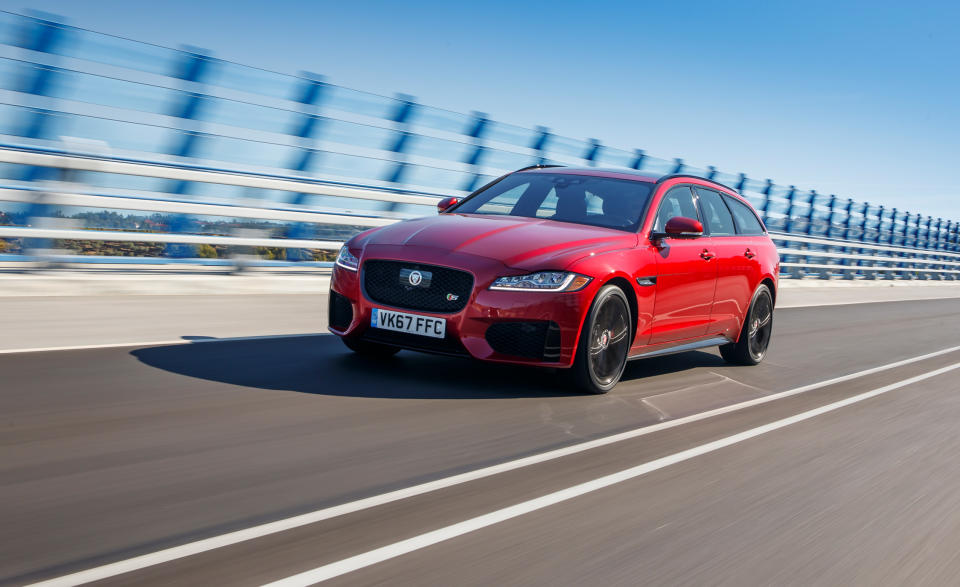2018 Jaguar XF S Sportbrake

When the second-generation Jaguar XF arrived in 2016 it made a splash no bigger than a raindrop falling into the Atlantic. Despite moving onto a new architecture and gaining two new four-cylinder engines, the wholly redesigned XF looks as if it received only a mild facelift. When the 2018 XF Sportbrake appears on roads in the United States near the end of this year, however, there will be no confusion about whether it’s Covington’s latest work. Jag hasn’t sold a wagon in this country since the unloved X-type departed nine years ago.
Sportbrake sightings will be rare, though. Americans love a $71,445 wagon like they love Marmite, and this Jaguar’s entrance will make the mid-size luxury-wagon segment a crowded one. The Mercedes-Benz E400 and the Volvo V90 Cross Country, both boasting long wagon lineages in the States, have sybaritic luxury and comfort well covered.

Jaguar hopes the Sportbrake can carve out its own niche within a niche as a sporty driver’s car for right-brained pragmatists. With the model’s success likely to be measured in hundreds of units sold every year, the Brits initially will import the Sportbrake to the States in a single configuration: the XF S Sportbrake with a supercharged 380-hp V-6, an eight-speed automatic transmission, and all-wheel drive. (Jaguar recently announced that more affordable Sportbrake models are coming here eventually, but no other details were given.)
It Zigs, It Zags, It Kind of Mumbles
The Sportbrake demonstrated typical Jaguar chassis prowess on asphalt snaking through northern Portugal’s rolling landscapes. The XF steers with on-center alacrity and just the right amount of power assist. Brake-based torque vectoring helps this roughly 4350-pounder turn-in and hold a line, yet it also left the pads and rotors radiating heat and stink on a spirited but not exactly aggressive run. Body roll is controlled well enough that this wagon still has an edge on Jaguar’s dynamically adept F-Pace crossover.
We should mention that our European drive did tilt the playing field in the Jaguar’s favor. Continental ContiSportContact 5P summer tires elevated the Sportbrake's lateral grip beyond what buyers will experience in the U.S., where Jaguar will fit only all-season tires on either 19- or 20-inch wheels. And Portugal’s impeccably maintained roads offered few opportunities to evaluate impact harshness, so it’ll take us getting one on our home turf—and its pockmarked pavement—to render final judgment in that regard.

It’s the powertrain that keeps the Sportbrake from fulfilling its complete mission as a dynamic standout. Despite its sizable output—about 60 horsepower more than the Mercedes or the Volvo—the 3.0-liter V-6 lacks the instant-on punch you expect of a supercharged engine. That’s exacerbated by the ZF-supplied eight-speed transmission that is slow to kick down. Shifts also lack the crispness that makes this same automatic gearbox so satisfying in dozens of Audi and BMW models. The engine note is a letdown, too, monotonous and mumbling even at full load. After investing big money in its new four-cylinder engines and aluminum-intensive architecture, it’s time for Jag to turn its attention to its sixes and eights.
Great for Cargo, except When That Cargo Is Human
All Sportbrakes come with a self-leveling air-spring suspension to combat the dragging-wagon rake that otherwise occurs when you fill the load space to capacity. Cargo volume expands from the XF sedan’s 19 cubic feet to 32 here with the rear seats up, only two less than the F-Pace. With the rear seats folded to make a flat load floor, the Sportbrake has 70 cubic feet of space, six cubes more than the F-Pace. The XF is less adept at carrying human cargo, though. The front seats are nearly as flat and firm as the cargo floor and grow tiresome over long drives, and those same complaints only grow louder when you sit in the shapeless rear seats. At least there’s generous legroom and headroom for adults back there.

All U.S.-market Sportbrakes will come with features like front and rear parking sensors, blind-spot monitoring, and adaptive dampers as standard. Jaguar also will offer just 20 First Edition cars in the U.S. painted in Farallon Black, a metallic paint with subtle flakes of red and blue that’s typically reserved for use by Jaguar Land Rover’s SVO personalization division. First Edition cars add a selection of tech equipment as standard that is optional on the normal Sportbrake, including a Wi-Fi hotspot, an upgraded Meridian sound system, and Jaguar’s Activity Key that allows its owner to lock and unlock the car with a Fitbit-like wristband. There’s also a gesture-control feature that allows front-seat occupants to open the sunshade on the massive fixed-pane glass roof with an overhand wave.
True to Form
Back in the 1950s, Jaguar founder Sir William Lyons steered product development with the motto, “grace, space, and pace.” The Jaguar XF S Sportbrake appears tailor-built to that adage. The design is timeless, the interior is roomy enough for four adults and their sundries, and the chassis carves roads with confidence. In the brand’s current lineup, there is no other vehicle that better encapsulates Lyon’s founding principles.
Specifications >
VEHICLE TYPE: front-engine, all-wheel-drive, 5-passenger, 4-door hatchback
BASE PRICES: XF S AWD, $71,445;
First Edition, $73,095
ENGINE TYPE: supercharged and intercooled DOHC 24-valve V-6, aluminum block and heads, direct fuel injection
Displacement: 183 cu in, 2995 cc
Power: 380 hp @ 6500 rpm
Torque: 332 lb-ft @ 4500 rpm
TRANSMISSION: 8-speed automatic with manual shifting mode
DIMENSIONS:
Wheelbase: 116.5 in
Length: 195.1 in
Width: 74.0 in Height: 58.9 in
Passenger volume: 98 cu ft
Cargo volume: 32 cu ft
Curb weight (C/D est): 4350 lb
PERFORMANCE (C/D EST):
Zero to 60 mph: 5.3 sec
Zero to 100 mph: 12.5 sec
Standing ¼-mile: 13.8 sec
Top speed: 121 mph
EPA FUEL ECONOMY (C/D EST):
Combined/city/highway: 22/19/27 mpg

 Yahoo Autos
Yahoo Autos 